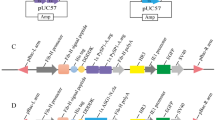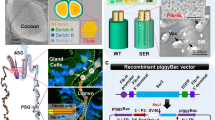Abstract
Spider dragline silk is a unique fibrous protein with a combination of tensile strength and elasticity, but the isolation of large amounts of silk from spiders is not feasible. In this study, we generated germline-transgenic silkworms (Bombyx mori) that spun cocoons containing recombinant spider silk. A piggyBac-based transformation vector was constructed that carried spider dragline silk (MaSp1) cDNA driven by the sericin 1 promoter. Silkworm eggs were injected with the vector, producing transgenic silkworms displaying DsRed fluorescence in their eyes. Genotyping analysis confirmed the integration of the MaSp1 gene into the genome of the transgenic silkworms, and silk protein analysis revealed its expression and secretion in the cocoon. Compared with wild-type silk, the recombinant silk displayed a higher tensile strength and elasticity. The results indicate the potential for producing recombinant spider silk in transgenic B. mori.





Similar content being viewed by others
References
Rising A, Nimmervoll H, Grip S, Fernandez-Arias A, Storckenfeldt E, Knight DP, Vollrath F, Engström W (2005) Spider silk protein mechanical property and gene sequence. Zool Sci 22:273–281
Vollrath F, Knight DP (2001) Liquid crystalline spinning of spider silk. Nature 410:541–548
Hinman MB, Jones JA, Lewis RV (2000) Synthetic spider silk: a modular fiber. Trends Biotechnol 18:374–379
Hu X, Vasanthavada K, Kohler K, McNary S, Moore AM, Vierra CA (2006) Molecular mechanisms of spider silk. Cell Mol Life Sci 63:1986–1999
Xu M, Lewis RV (1990) Structure of a protein superfiber: spider dragline silk. Proc Natl Acad Sci USA 87:7120–7124
Hinman MB, Lewis RV (1992) Isolation of a clone encoding a second dragline silk fibroin. Nephila clavipes dragline silk is a two-protein fiber. J Biol Chem 267:19320–19324
Ayoub NA, Garb JE, Tinghitella RM, Collin MA, Hayashi CY (2007) Blueprint for a high-performance biomaterial: full-length spider dragline silk genes. PLoS ONE 2:e514
Zhang H, Liu J (2005) Molecular architecture and engineering of spider dragline silk protein. Prog Nat Sci 15:769–776
Fahnestock SR, Irwin SL (1997) Synthetic spider dragline silk proteins and their production in Escherichia coli. Appl Microbiol Biotechnol 47:23–32
Fahnestock SR, Bedzyk LA (1997) Production of synthetic spider dragline silk protein in Pichia pastoris. Appl Microbiol Biotechnol 47:33–39
Lazaris A, Arcidiacono S, Huang Y, Zhou JF, Duguay F, Chretien N, Welsh EA et al (2002) Spider silk fibers spun from soluble recombinant silk produced in mammalian cells. Science 295:472–476
Teule F, Cooper AR, Furin WA, Bittencourt D, Rech EL, Brooks A, Lewis RV (2009) A protocol for the production of recombinant spider silk-like proteins for artificial fiber spinning. Nat Protoc 4:341–355
Lewis RV, Hinman M, Kothakota S, Fournier MJ (1996) Expression and purification of a spider silk protein: a new strategy for producing repetitive proteins. Protein Expr Purif 7:400–406
Scheller J, Gührs KH, Grosse F, Conrad U (2001) Production of spider silk proteins in tobacco and potato. Nat Biotechnol 19:573–577
Zhou CZ, Confalonieri F, Medina N, Zivanovic Y, Esnault C, Yang T, Jacquet M et al (2000) Fine organization of Bombyx mori fibroin heavy chain gene. Nucleic Acids Res 28:2413–2419
Tamura T, Thibert C, Royer C, Kanda T, Abraham E, Kamba M, Komoto N et al (2000) Germline transformation of the silkworm Bombyx mori L. using a piggyBac transposon-derived vector. Nat Biotechnol 18:81–84
Tomita M, Munetsuna H, Sato T, Adachi T, Hino R, Hayashi M, Shimizu K et al (2003) Transgenic silkworms produce recombinant human type III procollagen in cocoons. Nat Biotechnol 21:52–56
Royer C, Jalabert A, Da Rocha M, Grenier AM, Mauchamp B, Couble P, Chavancy G (2005) Biosynthesis and cocoon-export of a recombinant globular protein in transgenic silkworms. Transgenic Res 14:463–472
Imamura M, Nakahara Y, Kanda T, Tamura T, Taniai K (2006) A transgenic silkworm expressing the immune-inducible cecropin B-GFP reporter gene. Insect Biochem Mol Biol 36:429–434
Ogawa S, Tomita M, Shimizu K, Yoshizato K (2007) Generation of a transgenic silkworm that secretes recombinant proteins in the sericin layer of cocoon: production of recombinant human serum albumin. J Biotechnol 128:531–544
Tomita M, Hino R, Ogawa S, Iizuka M, Adachi T, Shimizu K, Sotoshiro H et al (2007) A germline transgenic silkworm that secretes recombinant proteins in the sericin layer of cocoon. Transgenic Res 16:449–465
Tateno M, Toyooka M, Shikano Y, Takeda S, Kuwabara N, Sezutsu H, Tamura T (2009) Production and characterization of the recombinant human {micro}-opioid receptor from transgenic silkworms. J Biochem 145:37–42
Zhang Y, Hu J, Miao Y, Zhao A, Zhao T, Wu D, Liang L et al (2008) Expression of EGFP-spider dragline silk fusion protein in BmN cells and larvae of silkworm showed the solubility is primary limit for dragline proteins yield. Mol Biol Rep 35:329–335
Zhao AC, Zhao TF, Nakagaki K, Zhang YS, Sima YH, Miao YG, Shiomi K, Takadera M, Nakagaki M et al (2006) Novel molecular and mechanical properties of egg case silk from wasp spider Argiope bruennichi. Biochemistry 45:3348–3356
Zhao A, Zhao T, Sima Y, Zhang Y, Nakagaki K, Miao Y, Shiomi K et al (2005) Unique molecular architecture of egg case silk protein in a spider, Nephila clavata. J Biochem 138:593–604
Miao Y, Zhang Y, Nakagaki K, Zhao T, Zhao A, Meng Y, Nakagaki M et al (2006) Expression of spider flagelliform silk protein in Bombyx mori cell line by a novel Bac-to-Bac/BmNPV baculovirus expression system. Appl Microbiol Biotechnol 71:192–199
Zhang Y, Shimizu K, Shiomi K, Zenta K, Nakagaki M (2008) cDNA cloning of Nephila clavata dragline silk (MaSp1) gene and comparison with the sequence of Bombyx mori fibroin heavy chain. Sanshi-Konchu Biotec 77:39–45
Brosius J (1989) Superpolylinkers in cloning and expression vectors. DNA 8:759–777
Horn C, Schmid BG, Pogoda FS, Wimmer EA (2002) Fluorescent transformation markers for insect transgenesis. Insect Biochem Mol Biol 32:1221–1235
Yamada H, Nakao H, Takasu Y, Tsubouchi K (2001) Preparation of undegraded native molecular fibroin solution from silkworm cocoons. Mater Sci Eng C 14:41–46
Zhong B, Li J, Chen J, Ye J, Yu S (2007) Comparison of transformation efficiency of piggyBac transposon among three different silkworm Bombyx mori strains. Acta Biochim Biophys Sin (Shanghai) 39:117–122
Acknowledgments
This work was supported by (1) Grant-in-Aid for Global COE Program by the Ministry of Education, Culture, Sports, Science, and Technology, Japan; (2) Grant-in-Aid for Scientific Research (B) by Japan Society for the Promotion of Science, Japan; (3) Natural Science Foundation Project of CQ CSTC, China (CSTC, 2008BA1008); (4) Natural Science Foundation Project of China SWU (SWUB2008008). We are indebted to the Division of Gene Research, Research Center for Human and Environmental Sciences, Shinshu University, for providing facilities.
Author information
Authors and Affiliations
Corresponding author
Rights and permissions
About this article
Cite this article
Wen, H., Lan, X., Zhang, Y. et al. Transgenic silkworms (Bombyx mori) produce recombinant spider dragline silk in cocoons. Mol Biol Rep 37, 1815–1821 (2010). https://doi.org/10.1007/s11033-009-9615-2
Received:
Accepted:
Published:
Issue Date:
DOI: https://doi.org/10.1007/s11033-009-9615-2




